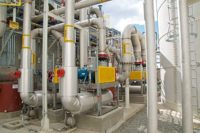When you do the math, it’s clear that high efficiency motors save on costs, energy.
The biggest benefits to using a high or premium efficiency motor are what it will help you save - energy ¬- and what it will help you gain - dollars. The largest gains become apparent when you use the motor more than 4,000 hours per year. Each point of increased efficiency can help you save significant dollar amounts each year.
A common rule of thumb that can be used when choosing a high or premium efficiency motor instead of a standard or epact efficiency motor is the $15-per-horsepower-per-point rule. To verify that the high efficiency motor is a better value, multiply $15 times the hp rating of the motors, times the difference in the efficiency ratings of the two motors.
For example, the list price of a standard, epact efficiency 10-hp motor is $780, and the list price of a high, premium efficiency motor is $987. The list price difference is $207. So, the standard, epact efficiency 10-hp motor is rated 89.5 percent efficient at full load and the high, premium efficiency 10-hp motor is rated 91.7 percent efficient at full load.
The difference in efficiency ratings here is 2.2. So, take $15 x 10 x 2.2 and you get 330. The $330 amount is higher than the cost difference of $207 between the two 10-hp motors, so the higher efficiency motor is a better deal and will save you money in energy consumption throughout the life of the motor.
Not only does a more efficient motor cost less to operate, the design features of the motor include high quality insulation materials and a well-insulated magnet wire, which will increase the motor’s reliability and extend its life.
Before purchasing, you also must understand what load or hp is required to drive the pump. A motor is most efficient if run within 65 percent to 100 percent of its rated load, which is measured by the motor’s current draw. Unlike a gas-powered engine, an AC electric motor is most efficient if run at, or close to, its full-load rating.
An under-utilized motor has a high amount of “lost” watts, which translates to a higher motor operating temperature that could lead to premature failure.
Besides selecting a motor that is designed to run at its rated load for the application, system designers also should select a motor according to what speed is needed to fit the application. Pump applications are more sensitive to speed variations, so a motor that has an rpm rating that is higher than what the pump is designed for, will lead to higher flow, reduced efficiency and an increase in energy consumption.
Another factor to consider when ordering a motor is whether or not your local utility company offers rebates to consumers that purchase high efficiency motors.
Also note that this application may be enhanced if you use a variable frequency control (VFD) to control the speed of the motor. This especially is useful in pump applications.
Chris H. Medinger is the stock products manager and Kevin Heinecke is the manager of AC application engineering for Leeson Electric Corp., Grafton, Wis. Readers may contact them at medingch@leeson.com and heinecke@leeson.com.
Related Articles
Events
View AllSubmit An Event-
January 16, 2013 Northwest Industrial Energy Efficiency Summit
×
Get our new eMagazine delivered to your inbox every month.
Stay in the know on the latest food and beverage manufacturing markets.
SUBSCRIBE TODAYCopyright ©2024. All Rights Reserved BNP Media.
Design, CMS, Hosting & Web Development :: ePublishing


